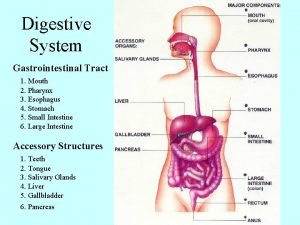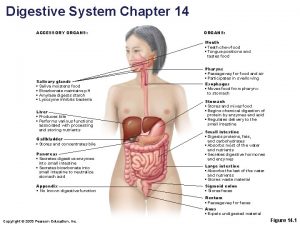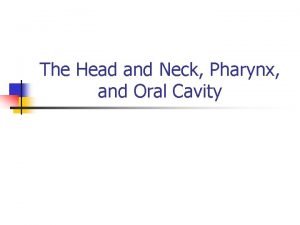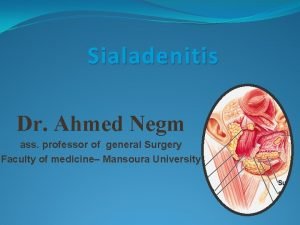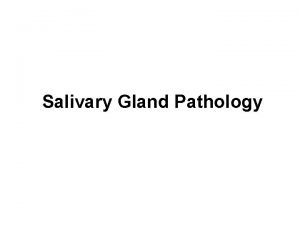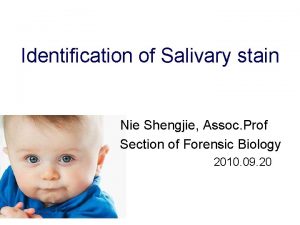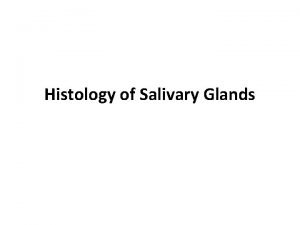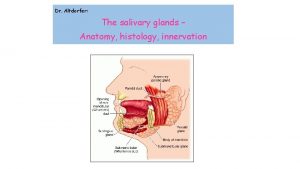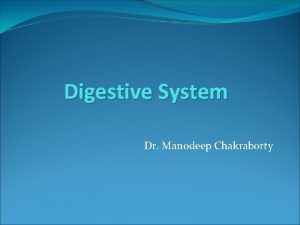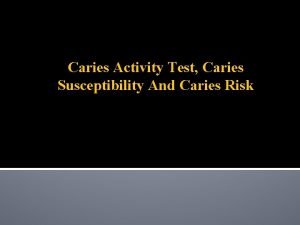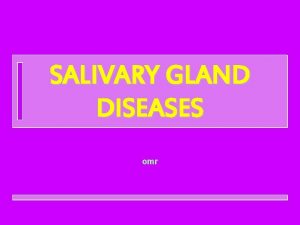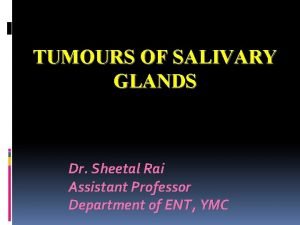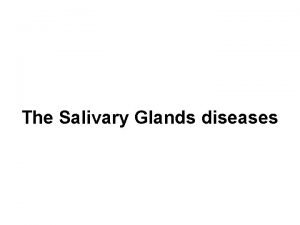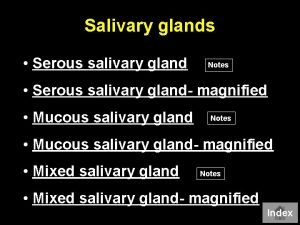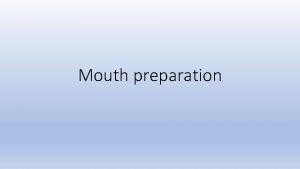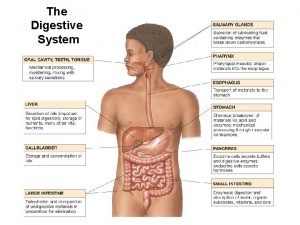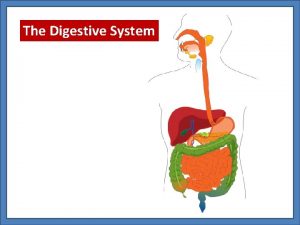The Digestive System Generalities the Mouth and Salivary

















- Slides: 17

The Digestive System Generalities, the Mouth and Salivary Glands

Human Digestive System Digestion – the breakdown of food and absorption of resulting nutrients by cells n Structures n Alimentary canal (mouth, pharynx, esophagus, stomach, small intestine, large intestine, anal canal) n Accessory (teeth, tongue, salivary glands, liver, gall bladder, pancreas) n n Basics: tube, open at both ends, 186 m 2

mouth pharynx


Structure of Wall n Mucosa – mucous membrane of surface epithelium, underlying CT, and small amount of smooth muscle tissue n Folded in some regions to increase surface area in lumen (digestive tube)

Movements of the Tube n Two main types of movement n n Mixing – smooth muscles in small segments of tube contract rhythmically Propelling – wavelike motion called peristalsis n n Ring of contraction appears in wall of tube and wall ahead of ring relaxes Pushes tubular contents ahead of wave

Mouth – primary site of digestion n Reduces size of food particles (mechanical digestion) Mixes with saliva (chemical digestion) Lips, cheeks, tongue, and palate n n Oral cavity – between palate and tongue Vestibule – narrow space between teeth and cheeks

Mouth cont. n Tongue – nearly fills oral cavity when mouth is closed n n n Frenulum – connects midline of tongue to floor of mouth Skeletal muscle helps mix food w/ saliva and moves toward pharynx during swallowing Papillae – rough projects providing friction and taste buds

Mouth cont. n Palate – roof of oral cavity n n Anterior (hard palate) Posterior (soft palate) – muscular arch that extends posteriorly and downward as a cone shaped projection uvula n During swallowing muscles draw uvula upward to close opening between nasal cavity and pharynx you may squirt food out your nose if this action isn’t completed fully before swallowing


Teeth n Two sets during development n n n Primary (baby teeth) – shed in same order they appear root reabsorbed before pressure from secondary teeth pushes out Secondary (permanent) – 32 total (16 in each jaw) Break down food into smaller pieces thus increasing surface area of particles

Teeth cont. n Incisors – 4 central, 4 lateral n n Cuspids – 4 n n Grasping and tearing food Bicuspids – 4 first, 4 second n n Biting off pieces Grinding Molars – 4 first, 4 second, 4 third n Grinding

Teeth cont. n Crown – portion of tooth above gum n White enamel covering – calcium salts (hardest substance in the body) n n Cannot be replaced if damaged Dentin – bone like substance surrounds central cavity (pulp cavity that extends into root)

Teeth cont. n Root – portion below gum n n n Pulp cavity – contains blood vessels, nerves and a CT called pulp Cementum – thin layer of bonelike material encloses root Periodontal ligament – surrounds cementum with dense CT attaching tooth to jaw

Salivary Glands n n Secrete saliva – moistens food particles, binds them, and begins chemical digestion of carbohydrates Two types of cells n Serous cells – produce watery fluid that contains digestive enzyme amylase n n Amylase splits starch and glycogen into disaccharides Mucous cells – secrete thick mucus n Binds food particles and lubricates during swallowing

Salivary Glands cont. n Three major pairs n Parotid glands – largest, lying anterior and somewhat inferior to each ear n n Submandibular glands – floor of mouth, on inside surface of lower jaw n n Secretions rich in amylase Predominately serous, with a few mucous cells Sublingual glands – smallest, floor of mouth, inferior to tongue n Mainly mucous, secretions thick and stringy

Salivary Glands
 Amylase
Amylase Figure 14-1 digestive system
Figure 14-1 digestive system Ingestion digestive system
Ingestion digestive system Respiratory digestive and circulatory system
Respiratory digestive and circulatory system Nervous system and digestive system
Nervous system and digestive system Card stacking commercial examples
Card stacking commercial examples Salivary gland
Salivary gland Types of salivary glands
Types of salivary glands Salivary gland pathology
Salivary gland pathology Nie wiem association
Nie wiem association Gland histology
Gland histology Glandula submandibularis
Glandula submandibularis Composition of mucus
Composition of mucus Dentocult lb test
Dentocult lb test Caries susceptibility tests
Caries susceptibility tests Salivary gland disease classification
Salivary gland disease classification Warthin's tumor
Warthin's tumor Basal cell adenoma
Basal cell adenoma
